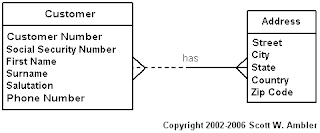Conceptual data models. These models, sometimes called domain models, are typically used to explore domain concepts with project stakeholders. On Agile teams high-level conceptual models are often created as part of your initial requirements envisioning efforts as they are used to explore the high-level static business structures and concepts. On traditional teams conceptual data models are often created as the precursor to LDMs or as alternatives to LDMs.
Logical data models (LDMs). LDMs are used to explore the domain concepts, and their relationships, of your problem domain. This could be done for the scope of a single project or for your entire enterprise. LDMs depict the logical entity types, typically referred to simply as entity types, the data attributes describing those entities, and the relationships between the entities. LDMs are rarely used on Agile projects although often are on traditional projects (where they rarely seem to add much value in practice).
Physical data models (PDMs). PDMs are used to design the internal schema of a database, depicting the data tables, the data columns of those tables, and the relationships between the tables. PDMs often prove to be useful on both Agile and traditional projects and as a result the focus of this article is on physical modeling.
Although LDMs and PDMs sound very similar, and they in fact are, the level of detail that they model can be significantly different. This is because the goals for each diagram is different – you can use an LDM to explore domain concepts with your stakeholders and the PDM to define your database design.
Figure 1. A simple logical data model.

Figure 2. A simple physical data model.

For example, figure above examine the relationship between Customer and Address there really should be two names “Each CUSTOMER may be located in one or more ADDRESSES” and “Each ADDRESS may be the site of one or more CUSTOMERS”.
What About Conceptual Models?
Halpin (2001) points out that many data professionals prefer to create an Object-Role Model (ORM), an example is depicted in Figure 3, instead of an LDM for a conceptual model. The advantage is that the notation is very simple, something your project stakeholders can quickly grasp, although the disadvantage is that the models become large very quickly. ORMs enable you to first explore actual data examples instead of simply jumping to a potentially incorrect abstraction – for example Figure 3 examines the relationship between customers and addresses in detail.
Figure 3. A simple Object-Role Model.

Common Data Modeling Notations:
Figure 4 above presents a summary of the syntax of four common data modeling notations: Information Engineering (IE), Barker, IDEF1X, and the Unified Modeling Language (UML).
source: datamodeling

No comments:
Post a Comment